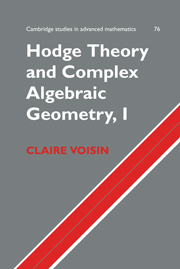11 - Hodge Classes
Published online by Cambridge University Press: 21 January 2010
Summary
The last two chapters of this volume form an introduction to a subject which is one of the major themes of the second volume: the interaction between algebraic cycles and the Hodge theory of a projective smooth complex variety. Here, we remain in the framework of Kähler geometry; thus we consider analytic cycles, which are combinations with integral coefficients of irreducible closed analytic subsets.
The first object associated to an analytic cycle in a compact complex manifold is its homology class. More generally, without any compactness hypothesis, we can define the cohomology class [Z] ∈ H2k (X, ℤ) of an analytic subset of codimension k of a complex manifold. When the components Zi of the cycle Z = ΣiniZi are smooth, this class [Z] = Σini[Zi] is easy to define, using a tubular neighbourhood of Zi and Thom's theorem. In the singular case, we reduce to the preceding case by showing that the singular locus of Zi is stratified by real submanifolds of codimension ≥ 2k + 2 in X, so that we have H2k (X, ℤ) = H2k (X – Sing Zi, ℤ).
An easy but important point is the fact that if X is a compact Kähler manifold, the class of an analytic cycle of codimension k is a Hodge class, i.e. an integral class which is of type (k, k) in the Hodge decomposition. In the second section, we give other examples of Hodge classes on a Kähler manifold. These are the Chern classes of holomorphic vector bundles. Thus, a Kähler manifold, which does not necessarily contain non-trivial analytic subsets, nevertheless has Hodge classes given by Chern classes of its tangent bundle.
- Type
- Chapter
- Information
- Hodge Theory and Complex Algebraic Geometry I , pp. 263 - 289Publisher: Cambridge University PressPrint publication year: 2002

